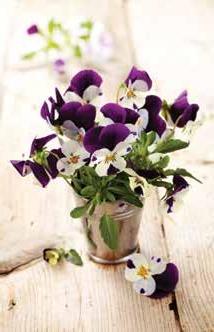
2 minute read
April in the Garden
My first experience with using flowers in food preparation came from the farmers market. I bought a salad mix with nasturtium flowers thrown in. The flowers made a beautiful garnish and added a subtle spicy radish taste, and they are also packed with vitamin C.
Since then, I’ve used a variety of edible flowers in salads. Borage is one of my favorites. The flowers are a wonderful blue color and taste like cucumbers. Calendulas, marigolds and nasturtiums also add a nice pop of color to salads.
Advertisement
Use edible herbs and flowers for subtlety in your food, not as a main course. Typically flowers from herbs pack a less flavorful punch than the greenery of a plant. Although plants have been used medicinally for thousands of years, too much of a good thing can set off allergies, upset your stomach and even interact negatively with medication. Positively identify the plants and flowers before you eat them.
Top your salad with colorful and tasty nasturtiums and borage.
Even if you are only using a flower for garnish, be sure it is edible. Be aware that some parts of a plant may be edible but other parts may not safe for eating. For example, flowers from pea plants are edible, but the beautiful, scented sweet peas grown for cut flowers are not.
Use lavender in your lemonade and freeze edible flowers in ice cubes. Mash herbs into butter for extra flavoring on bread. Sprinkle flower petals on salads and rice or garnish a plate with an orchid or rose. And don’t forget to top off your dining experience with a vase of beautiful flowers to feast the eyes in addition to the palate.

DIGGING DEEPER
April is National
Gardening Month and Coronado is all spruced up for Flower Show weekend (April 13 & 14), so take a walk to see our town looking its best. ✿ Garden Prep With all the recent rain, the soil has been compacted over the last few months. Add a layer of mulch in your garden to help rejuvenate the soil, suppress weeds and hold in the moisture. Mulching around roses also reduces water splashing and spreading fungus spores on leaves. ✿ Planting Nurseries and garden centers are overflowing with plants. Weekend gardeners are out in force, feeling energized by the warmer weather. Buying small plants can really stretch your dollar, but it is fun to splurge on a bigger plant to fill a specific area or pot. Look for compact plants with healthy

looking leaves. If they look wilted or rangy, they might be root bound. ✿ Watering Garden irrigation should be turned on by now. With all the new growth on plants, it’s important not to let them dry out, especially if we have a few days of hot weather.
✿ Fertilizer Iron deficiency shows up in plants as yellowing leaves with green veins. Use a fertilizer that contains chelated iron combined with zinc. ✿ Pest & Disease Control Warmer weather means that garden pests are ready to feast on fresh growth. Visit ipm.ucdavis.edu for information on integrated pest management from the University of California. ✿ Pruning Encourage a longer blooming cycle by cutting flowers regularly. Spread a bit of springtime by sharing your flowers with neighbors! ✿ Miscellaneous When entering plants in the Flower Show, clean detritus around the plant for better showing. Clean off the outside of the pot, too. The judges pay attention to that kind of thing. Good luck!




